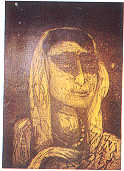

chosen surface to another has been pratticed in India from remote antiquity as evidenced in the seals of Indus Valley Civilisation. Also, embossed images of gods and goddesses on metal and block prints on textiles were common forms of traditional printing which are still in practice. However, there has been no evidence of printing on paper, manually or mechanically, that dates prior to 1556 when Jesuit missionaries settled in Goa imported two wooden presses and printed multiples of images and words for religious propagation. It was the British who introduced modern graphic techniques in India. Unlike the Jesuits who used art-in-print to spread the Christian faith, the British, as rulers of the country then, used it primarily for administrative purposes. The printed image was put to use to project the supremacy of the Raj as also to artistically capture typical impressions of the land and it's
people as they perceived it - the images of snake charmers and the nautch girls that were part of a collector's portfolio produced by European artists here to be carried back as souvenirs. With the British introducing lithographic presses, India gradually transformed into a society dominated by the printed image, initially by the British and
then by Indian enterprise. In the pre-independence period, several of
the Bengal school artists who were essentially and sculptors tried printmaking as an alternate medium of expression, popularising the medium's creative use at the institutional level, but rarely used it for mass awakening and social protest. Most of the artists developed a prosaic, genre style, describing life around them as they perceived it. Except for Gaganendranath Tagore's lithographic cartoons that
initiated some form of social criticism and later Chittaprasad's bold
lino and wood cuts on communalism, Bengal Famine and other themes, graphic prints were not effectively explored during India's period of social and political stress. With a few exceptions, most artists did not produce a considerable body of prints. As a result, printmaking did not gain visibility or importance till well after independence.
Independence did not make for an instantaneous change from all
that was foreign in art. Although with independence, the transfer from foreign to native rule did occur but the country's art, like social and political systems, went through a period of transformation before it was geared to suit new needs, tastes and aspirations. The disturbed


Ajit Dubey
King
AmitabbaBanedee
MY
gmd mother
D Apte
Reflection ill


![]()
![]()



![]()